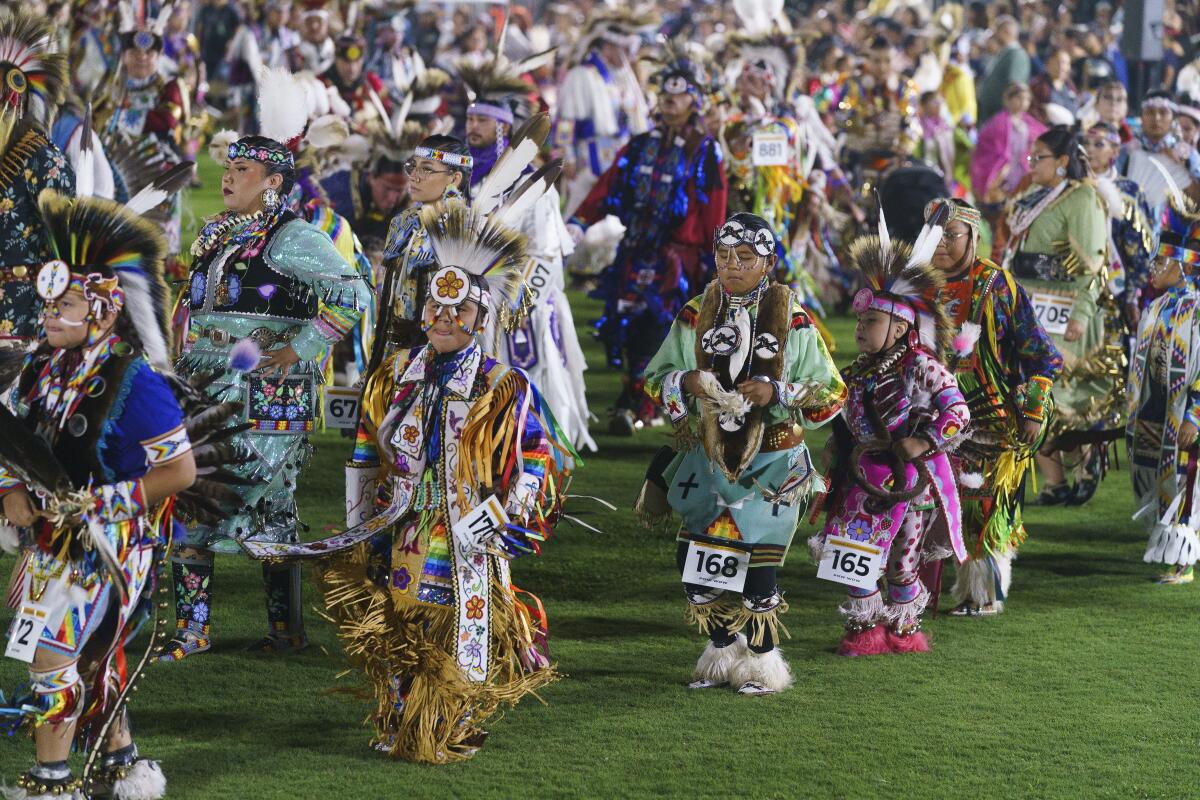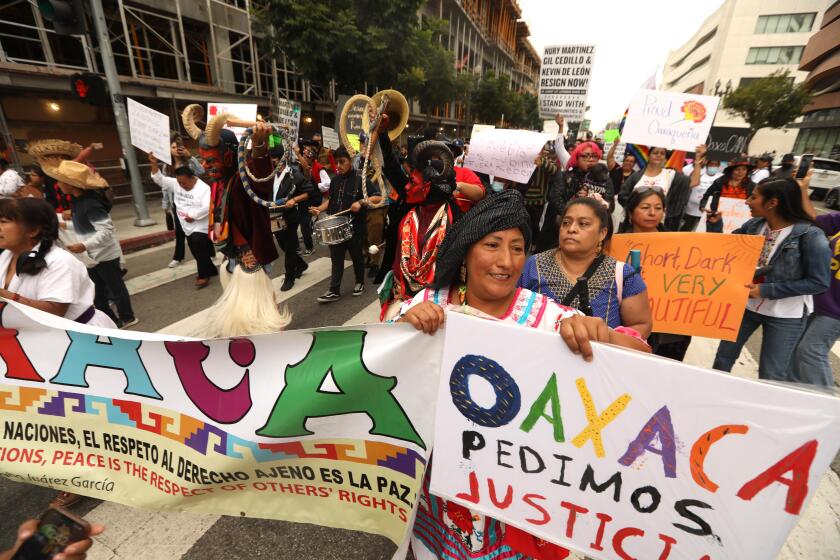Why so many California Indians lack the federal recognition given to other Native Americans

- Share via
Book Review
Unrecognized in California: Federal Acknowledgment and the San Luis Rey Band of Mission Indians
By Olivia M. Chilcote
University of Washington Press: 218 pages, $30
If you buy books linked on our site, The Times may earn a commission from Bookshop.org, whose fees support independent bookstores.
One September afternoon in 2016, I sat on a bench in front of the National Archives in Washington after a long day of research. As I scrolled through social media to pass the time before my ride arrived, a news release shared by a colleague caught my attention. In just two days, the National Museum of the American Indian would unveil, for the first time, one of the treaties the California Indian Nations had negotiated with the United States.
“The Treaty of Temecula is one of 18 treaties negotiated between the United States and American Indian Nations in California and submitted to the United States Senate on June 1, 1852, by President Millard Fillmore,” the announcement read. “Unbeknownst to the American Indian signatories, the U.S. Senate rejected the treaties and ordered them to be held in secrecy for over fifty years,” leaving the tribes “homeless without any local, state or federal legal recourse” and leading “to an ethnic cleansing in which the American Indian population in California plunged from perhaps 150,000 to 30,000 between 1846 and 1870.”
My heart skipped a beat. The museum planned to unveil the treaty that a captain of my tribe, San Diego County’s San Luis Rey Band of Mission Indians, had signed more than a century and a half ago to no avail.
Mining companies want to build a road through our land, disrupting wildlife and waterways. With the climate crisis, all humanity will suffer at the destruction of my homelands.
The news release went on to say that tribal representatives from four nations affected by the treaty would be present. I called my mom and asked whether she had heard about it through any tribal council communications. She confirmed that no one from my tribe was aware of the unveiling, even though our captain, Pedro Ka-wa-wish, was among the signatories. My mom cried on the other end of the line.
“Olivia,” she said, “you have to be there. … You need to represent San Luis Rey because no one else will.”
After unsuccessful attempts to communicate with museum officials, I arrived on the morning of the unveiling as an uninvited guest. I walked around the deserted sidewalks in front of the building for a few minutes until I saw some people enter through the glass doors. I followed.
An employee who took me for a tourist informed me that the museum was not yet open.
“I’m here for the treaty event,” I said confidently. She took out a list of invitees and asked for my affiliation, but she could not locate my tribe on the list. After I told her the San Luis Rey Band’s captain had signed the Treaty of Temecula, she decided to let me wait there as members of the invited tribal delegations viewed the treaty in private before its installation.
The tendency to lump Indigenous communities under the broad umbrella of “Hispanic/Latino” erases the cultural richness of the many Indigenous groups and limits the language support they need.
Once it was installed, I joined the invitees in the dimly lit exhibit space. We gathered around the treaty, which looked small compared with the glass case in which it rested, illuminated from above by a single light. The museum director delivered opening remarks before offering the floor to representatives of the Pechanga Band of Luiseño Indians, the Agua Caliente Band of Cahuilla Indians, the San Manuel Band of Mission Indians and the Ramona Band of Cahuilla.
The tribal leaders spoke powerfully about how the failure to ratify the treaties had affected California tribes. Mark Macarro, chairman of the Pechanga Band of Luiseño Indians, recollected fellow Native Americans insisting that “Mission Indians” are not like other Indians because they don’t have treaties with the United States. As he spoke, the Treaty of Temecula, negotiated within Pechanga territory, served as a physical reminder that the California Indian experience is just as valid as any Native American experience.

I felt humbled to be part of the unveiling ceremony and beamed with pride in my California Indian identity. But I also grew deeply uncomfortable, surrounded as I was by delegations of federally recognized tribes. I felt out of place as I remembered that no one had invited me or my tribe to participate in the historic occasion.
The treaty glaringly reminded me that the United States does not acknowledge the San Luis Rey Band of Mission Indians’ inherent sovereignty, despite our Gold Rush-era negotiations. I wondered why the museum did not inform my tribe about the event, and I could not help but think my community’s lack of federal recognition might be the reason. I looked at the treaty and saw Ka-wa-wish’s X-mark next to those of the Luiseño, Cupeño, Cahuilla and Serrano signatories. One hundred sixty-four years later, I stood alongside representatives of the very same people.

My experience at the unveiling illustrates the complexity and contradictions of unrecognized tribal status in California. The 18 treaties’ lack of ratification set the tone for the federal government’s long-standing uneven treatment of California Indian people and tribes. At the same time, the treaties became the key to strengthening California Indian activism in the early 20th century, which led to contemporary tribal pursuit of federal recognition.
California has more tribes that are not federally recognized than any other state, raising questions about California Indians’ history with the U.S. government, the politics of Native American identity and the problems of the Department of the Interior’s proffered path to recognition, known as the federal acknowledgment process. Eighty-one California tribes have sought acknowledgment since 1978, but just one has secured federal recognition.
California’s federally unrecognized tribes contend with intertwined legacies of Spanish and Mexican colonization, California- and U.S.-funded genocide, congressional refusal to ratify treaties and state tribal terminations. From the nature of our highly diverse pre-contact society of small, autonomous polities to the destructive forces of successive colonial regimes, California Indians’ distinct history is often incompatible with federal acknowledgment criteria.
The process is part of a long lineage of colonial policies designed to establish federal authority over Native communities. In pursuing federal recognition, tribes confront the United States’ enduring power to define Indigenous identities on its own terms. Even as unrecognized tribes work to assert their inherent sovereignty, settler structures serve to disempower us.
Olivia M. Chilcote is an assistant professor of American Indian studies at San Diego State University and the author of “Unrecognized in California: Federal Acknowledgment and the San Luis Rey Band of Mission Indians,” from which this is adapted.
More to Read
A cure for the common opinion
Get thought-provoking perspectives with our weekly newsletter.
You may occasionally receive promotional content from the Los Angeles Times.












